
The Hitch-Hiker is a 1953 American independent film noir thriller co-written and directed by Ida Lupino, and starring Edmond O'Brien, William Talman and Frank Lovejoy. Based on the 1950 killing spree of Billy Cook, the film follows two friends who are taken hostage by a murderous hitchhiker during an automobile trip to Mexico.

Ida Lupino was a British actress, director, writer, and producer. Throughout her 48-year career, she appeared in 59 films and directed eight, working primarily in the United States, where she became a citizen in 1948. She is widely regarded as the most prominent female filmmaker working in the 1950s during the Hollywood studio system. With her independent production company, she co-wrote and co-produced several social-message films and became the first woman to direct a film noir, The Hitch-Hiker, in 1953.

High Sierra is a 1941 American film noir directed by Raoul Walsh, written by William R. Burnett and John Huston from the novel by Burnett, and starring Ida Lupino and Humphrey Bogart. Its plot follows a career criminal who becomes involved in a jewel heist in a resort town in California's Sierra Nevada, along with a young former taxi dancer (Lupino).

The Big Clock is a 1948 American thriller directed by John Farrow and adapted by novelist-screenwriter Jonathan Latimer from the 1946 novel of the same title by Kenneth Fearing.
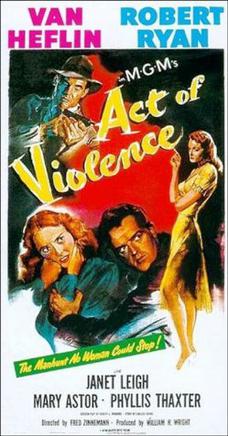
Act of Violence is a 1949 American film noir starring Van Heflin, Robert Ryan and featuring Janet Leigh, Mary Astor and Phyllis Thaxter.

Thieves' Highway is a 1949 American film noir directed by Jules Dassin and starring Richard Conte, Valentina Cortese and Lee J. Cobb. The screenplay was written by A. I. Bezzerides, based on his novel Thieves' Market. The film was released on DVD as part of the Criterion Collection in 2005.

They Drive by Night is a 1940 American film noir directed by Raoul Walsh and starring George Raft, Ann Sheridan, Ida Lupino, and Humphrey Bogart, and featuring Gale Page, Alan Hale, Roscoe Karns, John Litel and George Tobias. The picture involves a pair of embattled truck drivers and was released in the UK under the title The Road to Frisco. The film was based on A. I. Bezzerides' 1938 novel Long Haul, which was later reprinted under the title They Drive by Night to capitalize on the success of the film.

Private Hell 36 is a 1954 American crime film noir directed by Don Siegel starring Ida Lupino, Steve Cochran, Howard Duff, Dean Jagger and Dorothy Malone.
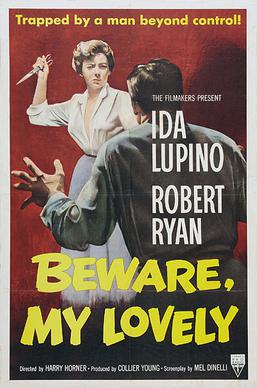
Beware, My Lovely is a 1952 American crime film noir directed by Harry Horner starring Ida Lupino, Robert Ryan and Taylor Holmes. The film is based on the 1950 play The Man by Mel Dinelli, who also wrote the screenplay.

The Man I Love is a 1947 American film noir melodrama directed by Raoul Walsh and starring Ida Lupino, Robert Alda, Andrea King and Bruce Bennett. Produced and distributed by Warner Brothers, the film is based on the novel Night Shift by Maritta M. Wolff. The title is taken from the George and Ira Gershwin song "The Man I Love", which is prominently featured.

Moontide is a 1942 American romantic drama with elements of a thriller. It was produced by Mark Hellinger and directed by Archie Mayo, who took over direction after the initial director Fritz Lang left the project early in the shooting schedule. The screenplay was written by John O'Hara and Nunnally Johnson (uncredited), based on the 1940 novel Moon Tide by Willard Robertson. The film features French star Jean Gabin, Ida Lupino, Thomas Mitchell and Claude Rains.
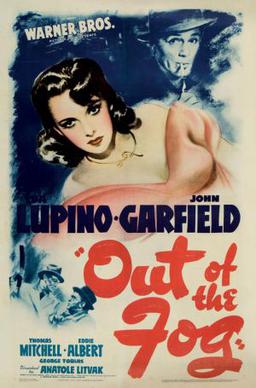
Out of the Fog is a 1941 American film noir crime drama directed by Anatole Litvak and starring John Garfield, Ida Lupino and Thomas Mitchell. The film was based on the play The Gentle People by Irwin Shaw. It was made and released by Warner Brothers.

Hard, Fast and Beautiful is a 1951 American drama film directed by Ida Lupino and starring Claire Trevor. It is loosely based on the 1930 novel American Girl by sports-fiction author John R. Tunis, which was an unflattering and thinly veiled fictionalization of the life of the tennis star Helen Wills Moody.
On Dangerous Ground is a 1952 film noir directed by Nicholas Ray and starring Ida Lupino and Robert Ryan.

A Bullet for Joey is a 1955 film noir directed by Lewis Allen and starring Edward G. Robinson and George Raft. The picture involves a gangster who sneaks into Canada to kidnap a scientist for the communists. The supporting cast features Audrey Totter, Peter van Eyck, George Dolenz, and Peter Hansen.

Diplomatic Courier is a 1952 American spy film noir directed by Henry Hathaway and starring Tyrone Power, Patricia Neal and Stephen McNally. The nightclub scene in the film features actor Arthur Blake, famous for his female impersonations, impersonating Carmen Miranda, Bette Davis, and Franklin D. Roosevelt. The plot was loosely adapted from the 1945 novel Sinister Errand by British writer Peter Cheyney.

Temptation is a 1946 American film noir thriller film directed by Irving Pichel and starring Merle Oberon, George Brent, Charles Korvin and Paul Lukas. The film was based on Robert Smythe Hichens's 1909 novel Bella Donna. Other film adaptations of the novel were produced in 1915, 1923 and 1934.
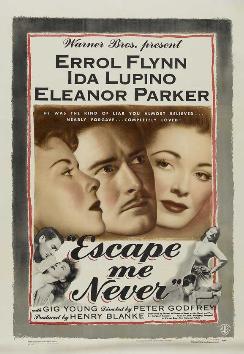
Escape Me Never is a 1947 American melodrama film directed by Peter Godfrey, and starring Errol Flynn, Ida Lupino, Eleanor Parker, and Gig Young.
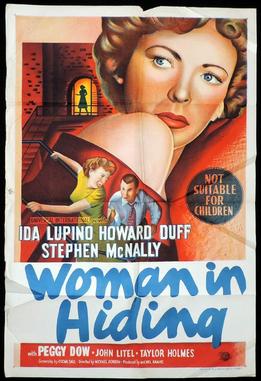
Woman in Hiding is a 1950 American melodrama thriller film starring Ida Lupino, Howard Duff and Stephen McNally. It was directed by Michael Gordon, with cinematography by William H. Daniels. Peggy Dow, John Litel, and Taylor Holmes, appear in support. Some observers regard the picture as a film noir, a view not universally embraced.
Virginia Majewski was an American viola and viola d’amore player.
















